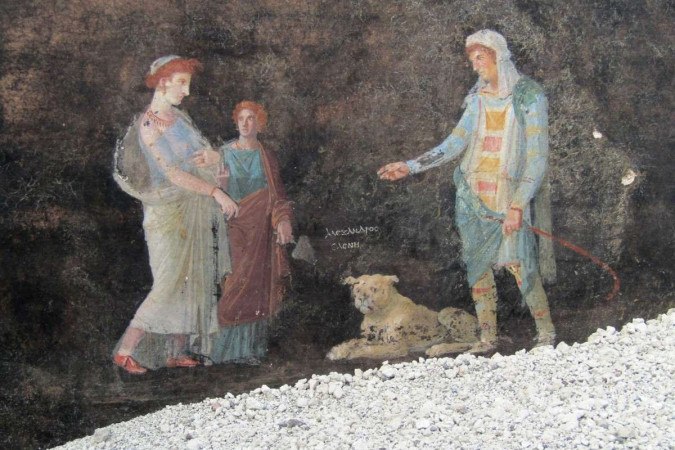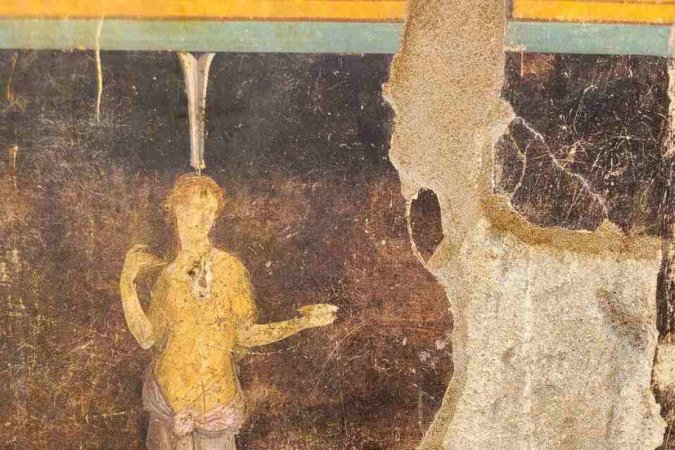
Uma descoberta encheu os olhos de admiradores da arte e da história. Afrescos muito bem preservados, temáticos da Guerra de Troia, que adornam um salão de banquetes em Pompeia foram revelados. As obras foram encontradas no famoso sítio arqueológico próximo a Nápoles, no sul da Itália.
- Estudo mostra que 64% das pessoas que tiveram covid longa seguem com sintomas
- Casos de AVC no mundo podem estar associados às mudanças climáticas
O salão, com 15 metros por seis de dimensão, exibe decorações muito trabalhadas, retratando temas mitológicos nas paredes e mosaicos de fundo preto, refletindo o estilo de vida luxuoso da antiga cidade coberta pelas cinzas da erupção do vulcão Vesúvio em 79 depois de Cristo.
Os afrescos ressaltam o heroísmo e apresentam casais e divindades centrais na narrativa da Guerra de Troia — que colocou em oposição gregos e troianos, durante cerca de 10 anos, no período anterior a Cristo. Além de enaltecer figuras mitológicas, as pinturas também abordam o destino humano e as possibilidades de influenciá-lo.
Entre os personagens representados estão Páris, o príncipe troiano que sequestrou a mulher do rei espartano Menelau, Helena, considerada a mais bela da Grécia, e que desencadeou a Guerra de Troia.
Também é possível observar Cassandra, irmã de Páris, e o deus Apolo — o deus da profecia e patrono dos médicos e artistas —, de quem recebe o dom de ver o futuro. Ela que alertou os compatriotas de que o cavalo oferecido pelos gregos era um subterfúgio que levaria Troia à sua ruína.
"A presença frequente de figuras mitológicas nos afrescos das salas de recepção das casas romanas tinha justamente a função social de entreter convidados e comensais, proporcionando temas de conversa e reflexão sobre o sentido da existência", explica a direção de Pompeia.
As paredes foram pintadas de preto para evitar que marcas de fumaça das lamparinas a óleo fossem vistas. O diretor de Pompeia, Gabriel Zuchtriegel, disse que, no salão onde foram localizadas as pinturas, havia uma aura capaz de criar um clima especial. "A luz das lamparinas dava a impressão de que as imagens pintadas se moviam, sobretudo depois de alguns copos de um bom vinho", conta ele.
Parte da chamada "cidade perdida" segue sob detritos vulcânicos. As cinzas vulcânicas expelidas há 2 mil anos pelo Vesúvio tomaram conta da maior parte das casas de Pompeia, o que garantiu a preservação quase completa das construções, bem como muitos dos corpos dos 3 mil mortos.
Segundo o ministro da Cultura, Gennaro Sangiuliano, o local é repleto de tesouros que aguardam ser desvendados. "(Pompeia) nunca deixa de nos surpreender porque cada vez que escavamos, encontramos algo bonito e significativo", afirmou.
Saiba Mais
Gostou da matéria? Escolha como acompanhar as principais notícias do Correio:
Dê a sua opinião! O Correio tem um espaço na edição impressa para publicar a opinião dos leitores pelo e-mail sredat.df@dabr.com.br
 Enem
Enem



